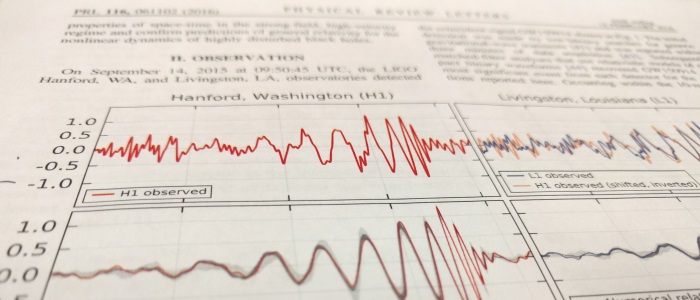A New Dawn

Throughout my undergraduate degree at Glasgow I kept hearing things about Gravitational Waves. I learned about them in my final year during General Relativity lectures, and I even worked within the group which was searching for them (though I was working on a fun project using data from the Kepler space telescope). But they hadn’t been discovered. Hundreds of physicists and astronomers had been working for decades, on detectors, software, and mathematics, trying to find them, but they’d remained completely elusive.
The idea that gravitational waves might exist goes back a hundred years to Einstein’s General Theory of Relativity, which explains gravity as being produced by space and time curving around heavy objects, a bit like how a mattress bends when you set a bowling ball on it. In 1906, Einstein realised his theory predicted that when the curvature of space changed somewhere in the universe a wave would travel out across spacetime, ‘updating’ the rest of the universe about the change. In the 1960s, it became clear that these gravitational waves might be detectable, and three CalTech scientists would be at the forefront of an effort to build the machine to detect them: Kip Thorne, a theorist, Rai Weiss, an experimentalist, and Ron Drever, an experimentalist (and a Scot).
Early attempts to detect gravitational waves involved apparatus which could fit inside a normal physics department lab, and Ron Drever, then at the University of Glasgow, had built and operated one of the earliest of these detectors (which is on display in the foyer of the University of Glasgow’s Kelvin Building). However, Drever, Weiss, and Thorne proposed something altogether more radical: a pair of detectors with 4-kilometre-long arms which would measure the positions of mirrors to subatomic precision. Their proposal would grow to become LIGO: the Large Interferometric Gravitational-wave Observatory, and over the following decades they would be joined by hundreds of scientists worldwide to build the most sensitive measuring device ever constructed.
In September 2015, the two detectors, one in Washington state and the other in Louisiana, had just completed their final pre-observing checks following a major programme of updates to improve their sensitivity. On 14th September, they’d been left on, ready to start formal observations later in the week.
The immortal words of one of the first e-mails I received during my PhD were:
“I guess we need to do the detection checklist”.
That sentence was probably the first indication that my PhD wasn’t going to have the nice breaking-in period that I was hoping for. On 14th September 2015, I’d just joined the Institute for Gravitational Research at the University of Glasgow, one of the groups around the world involved in the search for these elusive gravitational waves: ripples in spacetime, and I had just learned something I’d need to keep secret.
There had been a lot of talk within the group about a gamma ray burst which had occurred the week before, and I was quite confused about what was going on. It took a couple of days before I realised that the two events weren’t connected, and that what LIGO had detected was something entirely new.
But then… not much happened. It takes a long time to run a sensitive analysis on a signal, even if it was only 0.12 seconds long. I was distracted by all of the things that a new PhD student needs to do (like getting welcomed to the department, the college, the grad school…), and a few weeks went by. There was background chatter about GW150914 (that’s the catchy name which we started calling it once we were confident it was a real signal – a great improvement over its older trigger name). A major and exciting update came from the group responsible for analysing compact binary coalescences (CBCs) — collisions between pairs of black holes, neutron stars, or binaries made up of a black hole and a neutron star. They held a box opening.
In order to prevent interim results from biasing any other analysis, some results are kept secret from everyone. Then everyone agrees to get together and look at the results for the first time (they open the box) to see if they agree. The box opening for the data collected around 14th September was held as a teleconference. So many people joined the telecon to listen to the results that we actually broke the software (well, we hit a pre-configured limit, but that sounds less exciting). It turned out that the data was consistent with two black holes colliding.
The collaboration’s efforts didn’t stop. Work started on writing the paper which would announce the discovery in Physical Review Letters. Thousands of man-hours, and thousands of years of computer-time, had gone into the analysis of the data and the writing-up of papers. On 21st January, a meeting of the entire collaboration was held with over 600 people joining a single telecon. Our group at Glasgow gathered together in a lecture theatre to listen. At the meeting a vote was held: should we announce the detection?
I’d not been around long enough to have a vote (quite reasonably you’re expected to do some real science before you get to make decisions like that); but the excitement of waiting for the results in a room full of people who had been waiting decades for this moment was something I will never forget. The tension in the last minute, as the votes were counted, was sickening. The decision was overwhelming. The decision was to announce.
The next week was odd. There was an air of excitement all around our department; but it was tempered by the characteristic caution that physicists develop once their paper has been sent to be reviewed by a journal. There was also nothing any of us could do about it. I was waiting for internal reviewers to bring up suggestions about plots from our companion paper, and so I tried to get on with the work I’d been neglecting since before Christmas.
The day of the announcement drew nearer, and information about the press conference started to solidify. At the same time rumours started to pop up all over the internet (this wasn’t the first time we’d had a rumour event: there had been one in late September, and one in January too) that there would be a press conference, and that we’d be making an announcement about a detection. Keeping quiet about the news was a real struggle (and I pity the people who had to to endure all of my enthusiasm about this, which was bottled-up for six months, released all at once after the press conference).
In 2015, almost exactly 100 years after the development of General Relativity, the first direct detection of a gravitational wave was made. It was also the first detection of a black hole merger and the first detection of energy emission from a black hole. A wave which had travelled for over a billion years passed through a brand-new detector. The signal it created must be one of the most heavily-studied periods of time in Earth’s history.
With the detection of gravitational waves we have gained access to a new way to perceive the universe: 2016 marks the dawn of a new age of astronomy.
There can’t ever have been a more exciting time to start a PhD.
This article was copy edited by Andrew Denman.









